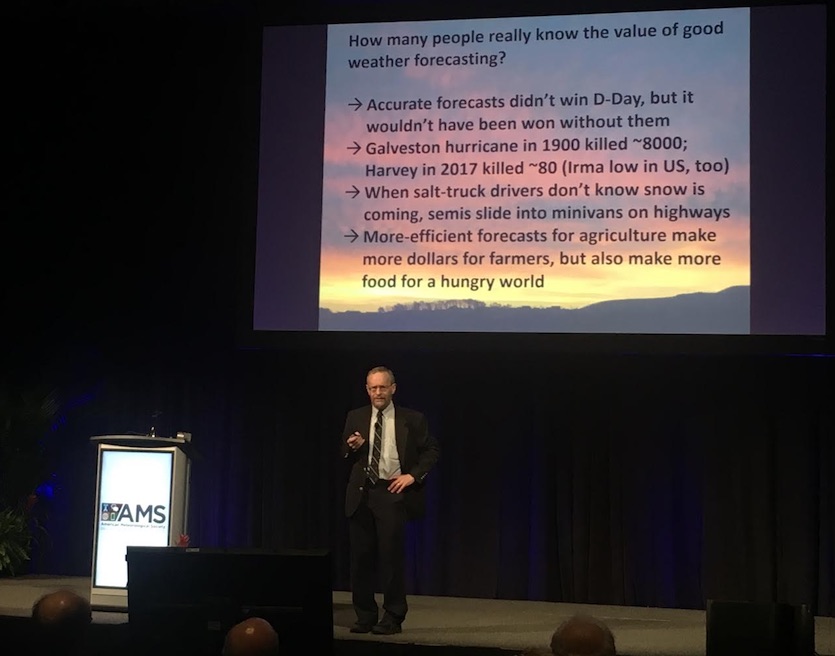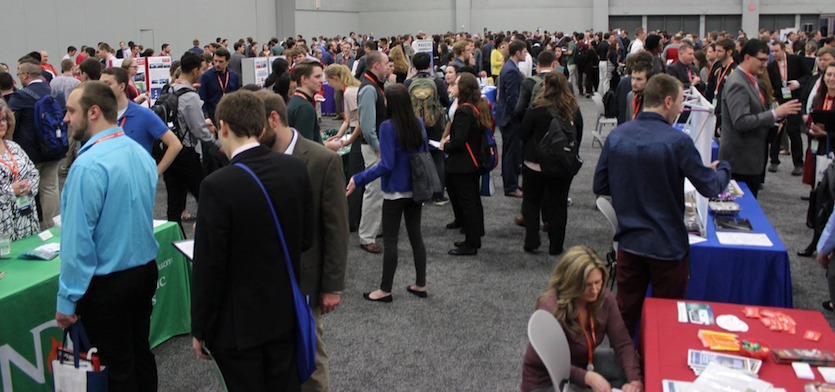| Above: Penn State geologist Richard Alley. Image credit: Courtesy PennStater. |
Eminent geologist and ace science communicator Richard Alley (Evan Pugh Professor of Geosciences, Pennsylvania State University) addressed a rapt audience of hundreds in Austin, Texas, on Sunday at the 98th Annual Meeting of the American Meteorological Society. Alley is author of The Two-Mile Time Machine: Ice Cores, Abrupt Climate Change, and Our Future and a member of the National Academy of Sciences. In 2011, he hosted the superb PBS series “Earth: An Operator’s Manual.”
Alley is one of the most talented climate communicators I know. I’ve long admired his ability to stay positive and good-natured even when talking about gravely important topics. Alley didn’t disappoint on Sunday, when he presented the keynote talk of the AMS Presidential Forum that opened the weeklong conference.
The conference theme, "Transforming Communication in the Weather, Water, and Climate Enterprise Focusing on Challenges Facing Our Sciences," was chosen by the late Matthew Parker, who died unexpectedly in March 2017 while serving as incoming AMS president. “Matthew J. Parker was committed to his meeting theme because he felt strongly that it conveyed the full potential for science to serve society,” said AMS. “He also felt strongly that communication is key to connecting current scientists with the next generation, ensuring a smooth transition into the future.”
 |
| Figure 1. Richard Alley delivers the Presidential Forum keynote at the American Meteorological Society’s annual meeting on Sunday, January 7, 2017. Image credit: Bob Henson |
The main point of Alley’s keynote talk was that science can make our lives better even if we don’t realize it. Some of the most important U.S. science and technology has happened when government agencies, universities, and the military collaborate. The computer chip in a cellphone, for instance, was based on transistors invented at Bell Laboratories with government funding. Cellphones, in turn, connect to the Internet, which began as ARPANET, a pioneering computer network funded by the U.S. Department of Defense and elaborated upon at universities. And cellphones hinge on the Global Positioning System (GPS), which draws on basic physics as well as Einstein’s theories of relativity. Because satellites experience less gravity than we do at Earth’s surface, about 10 kilometers of correction are needed each day for GPS positioning.
“Relativity works. Knowledge of relativity is essential,” said Alley. He added that when he was in college in the late 1970s, “I suspect most people would have named quantum mechanics and relativity as the most esoteric, useless sciences. Now they’re in our pockets. And modern life as we know it would not be possible without the technologies they enable.”
Academia, where much of this work was carried out, is now being scorned by large chunks of U.S. society. From 2010 through 2015, according to the Pew Research Center, a majority of Democrats and Republicans alike agreed that “colleges and universities have a positive effect on the way things are going in this country.” But by 2017, only 36% of Republicans agreed with that statement, a huge drop for a two-year period. Even if this newfound disgruntlement isn’t aimed directly at science departments, it could still affect institution-wide funding, Alley said.
Alley cited a modern paradox drawn from his own life: “People use their cell phones to send notes saying we scientists don’t know what we’re talking about. People who pay our salaries. Generally good people who have been misled.”
Newfangled science...that goes back to 1824
Even though the greenhouse effect was hypothesized almost 200 years ago by French scientist Joseph Fourier, the concept of humans enhancing this effect still runs up against intuition that goes all the way back to the cradle. “A toddler knows some things must be cleaned up, but it is common sense that gaseous emissions drift away,” Alley said. “The idea that we can change the very air, thus causing global warming, may not be common-sensical.”
Recent county-by-county research from the Yale Program on Climate Change Communication highlights another paradox. A mere 52% of Americans think global warming is caused mostly by human activities—yet 82% support research into renewable energy sources, which are a big part of strategies to limit climate change. As Alley put it, “Many people believe we can successfully solve problems they deny even exist.”
Alley’s talk could have been profoundly depressing were it not for his high spirits and good humor, which can’t be fully captured in quotes. If you haven’t seen Alley in action, I strongly encourage you to check out online segments from “Earth: The Operator’s Manual" (see example below). Alley closed his AMS talk by exhorting attendees to speak up for the value of science and the reality of climate change. “Getting from where we are to where we need to be will be a long, slow process…It’s going to take engaging all of you and a whole bunch more people, but I think we have to do this.”
An avalanche of atmospheric research
I’m spending this week at the AMS conference, where many hundreds of talks and posters will be presented—way more fascinating science than one can possibly absorb.
On Saturday, I took part in a lively media-oriented panel for the 17th Annual Student Conference, which has grown to record numbers (more than 700 attendees). I’ll also be opening the Robert T. Ryan Symposium with a lightning-round overview paying tribute to the career of this esteemed Washington weathercaster. Bob, a past AMS president, has not only been a hugely influential voice in support of U.S. science, in venues from Congress to K-12 schools, but he’s also penned articles for Science, Nature, and Weatherwise—a rare trifecta.
 |
| Figure 2. Hundreds of soon-to-be graduates and young professionals attended the AMS Student Conference Career Fair on Saturday night, January 6, 2017. Image credit: Courtesy AMS. |
On Sunday, I embarked on a three-year term as a member of the AMS Council, the society’s governing body. At my first Council meeting, I quickly realized how much I have yet to learn about the sheer depth and breadth of the AMS palette of activities, all powered by what one past president called a “ferocious” cadre of volunteers. More than 1200 of the AMS’s 12,000-plus members take on volunteer duties in some form or fashion—a vast level of involvement for a society this large. There are more than 140 boards and committees, and the society’s suite of highly regarded journals published more than 38,000 pages last year. More than 1240 fellowships and undergraduate scholarships have been awarded since 1991, and there are now close to 150 AMS local chapters nationwide.
It will be an honor and pleasure to serve as an AMS Council member over the next three years, especially with the society’s 100th anniversary year (2019) fast approaching. Among the many activities planned for the centennial is a landmark compilation of papers looking back at the last century—and ahead to the next one—across the full range of AMS weather, water, and climate research. In place of the usual Sun Belt location, the society’s headquarters city of Boston will play host for the 100th annual meeting in February 2020. It promises to be a memorable gathering. Will the anecdotal “annual meeting weather curse” deliver a classic nor’easter? Thus far it’s been mild and tranquil in Austin, so perhaps we're breaking the curse already!
Stay tuned for more news from the AMS meeting as the week unfolds. The #AMS2018 Twitter thread is a great place for up-to-the-minute news and photos, as is the AMS Facebook page.
“I often say the Annual Meeting should be on the bucket list of any weather enthusiast or professional in the field of weather, climate, meteorology, and atmospheric sciences.”
– Marshall Shepherd, University of Georgia and AMS past president



